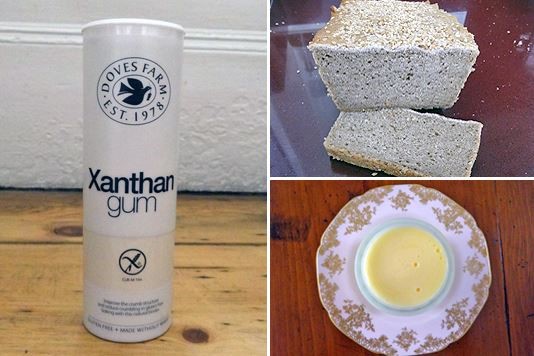
Experimental foodie Ilya Fisher tells us how to use Xanthan gum in everything from gluten-free bread to salad dressings and fancy sorbets.
Give Xanthan a chance
As one of the most frequently used food additives, I used to mistrust Xanthan gum. But it’s started to appear on supermarket shelves in its own right, which made me think that there must be something more to it. Besides, Doves Farm (those people who make lovely organic flour) produce Xanthan gum, so surely it can’t be that bad?
So what is Xanthan gum? The most succinct description I’ve found is on the Doves Farm website: “Xanthan is a natural gum produced by the fermentation of sugar with friendly bacteria… The sugar most commonly used for the fermentation process is corn syrup which is mixed with the bacterial starter and treated with nitrogen and trace elements and allowed to ferment. When fermentation is complete the syrupy broth is pasteurised to kill the bacteria. After filtering and washing the resulting solids are dried and ground to produce the gum.”
Green gunge and fake blood
Xanthan gum is apparently insignificant in small quantities (have a read of this article for more information on whether Xanthan gum is or isn’t healthy), so no need to worry about using it in recipes – you’ll never need large amounts of the stuff.
Xanthan gum also has some fascinating uses outside the food industry. Notably it’s found in cosmetics and fake blood, and is used in the oil industry to thicken drilling mud. It also helps make that green gunge beloved by children, which helps us to understand Xanthan gum’s gelatinous properties – it’s a thickener and a stabiliser.
Gluten-free bread

Salad dressing
Check out bottles of salad dressing in the supermarket – they usually include Xanthan gum in their ingredients list because of its thickening and stabilising properties. I made my favourite Japanese salad dressing (beautifully fragrant with fresh ginger and sesame oil) and added some Xanthan gum (¼ teaspoon per cup of dressing) to see if it would make a difference. The result was quite amazing. My grated ginger particles were evenly suspended in the dressing, and two days later the dressing had not separated. It’s beautifully emulsified.
In essence, adding a little Xanthan gum to a homemade salad dressing means you never have to shake and speedily pour it out again! If you add spices or finely chopped herbs they too will be evenly suspended. The dressing is thicker, but give the bottle a shake so that it temporarily thins into a pouring consistency. Then it will thicken again and stick perfectly to your salad leaves.
Molecular gastronomy
Xanthan gum’s thickening properties means it can turn liquids into sauces at both hot and cold temperatures. Because it’s flavourless and tiny quantities are used, typically 0.2-0.8% by weight, it won’t affect the taste either. This can lead to some exciting uses in molecular gastronomy. Ferran Adrià, ex-head chef of elBulli restaurant, used it to create the drink ‘white sangria in suspension’ in which herbs, small pieces of fruit and spherical caviar are suspended in clear alcohol.
Make your own soft-centred sorbets
Fancy using Xanthan gum yourself? Here's my recipe for individual soft-centred orange sorbets, perfect for a dinner party. It's easy to do, and only involves four ingredients.
These are just my early experiments – the beginnings of a new world of culinary adventures with Xanthan gum. Have you ever cooked with Xanthan gum? Have you any top tips to share? Talk to us in the Comments box below.
You might also like
Why I love cooking with... matcha